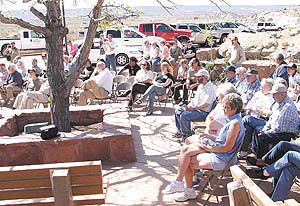| A good crowd showed up for the rededication that took place on Saturday morning. |
The Bureau of Land Management (BLM) held the rededication of the Cleveland-Lloyd Dinosaur Quarry with a ribboncutting ceremony Saturday.
The facility is BLM’s first visitor center and the rededication featured speakers from the BLM, Emery County and the Utah Museum of Natural History.
Some of those presenting the program included Jeff Horrocks, a county commissioner from Emery County, Mark Loewen who is a Ph. D. candidate at the University of Utah, Scott Sampson, a Canadian paleontologist, Jeff Rawson, associate director of the BLM for Utah, and Jim Madsen, who was the first state paleontologist for the state of Utah.
The quarry was originally dedicated in 1968. Guests at the rededication were able to view the newly renovated and expanded facilities and interact with paleontologists who were on hand to answer questions about the site.
The Cleveland-Lloyd Dinosaur Quarry is home to one of the most impressive collections of dinosaur fossils worldwide. The quarry contains a unique concentration of skeletons of the meat eating dinosaur Allosaurus, along with the bones of many other familiar dinosaurs, including Stegosaurus and the enormous long necked sauropods.
Over the years, excavations led by the University of Utah and the Utah Museum of Natural History have resulted in the collection of more than 12,000 bones from the quarry. While most of these fossils are currently housed at the Utah Museum of Natural History, many skeletons reproduced from Cleveland-Lloyd dinosaur remains are now on exhibit in more than 65 museums worldwide.
Many of the original bones from the quarry remain on public exhibit in Utah at the Utah Museum of Natural History, the Prehistoric Museum in Price, and the Earth Science Museum at BYU in Provo, but the new BLM visitor center at the Cleveland-Lloyd Dinosaur Quarry is the best place to really experience the quarry and its treasure trove of dinosaur fossils.
The new facility, which was developed by the BLM in collaboration with Insight Exhibits, the Utah Museum of Natural History, and Paleoforms Inc., features over 2000 square feet of interactive displays and exhibits. An updated and colorized bone bed map shows the scattering of approximately 20,000 various types of dinosaur bones, as they were initially discovered at the site. Another exhibit lists scientific theories that have been proposed to explain this unusual concentration of dinosaur remains, and compares them to the data collected.
Other exhibits include a display showing the excavation history of the site, a fossil preparation table, replica skulls of animals found in the quarry, and a new Allosaurus skeleton mount.
At the actual quarry, two observation platforms allow visitors to view the deposit from various angles. Here, visitors can see some of the original bones still in place and a reconstruction of a small portion of the quarry recently excavated and reproduced by the Utah Museum of Natural History.

